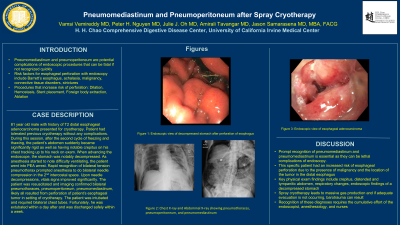Back

Poster Session C - Monday Afternoon
Category: Interventional Endoscopy
C0481 - Pneumomediastinum and Pneumoperitoneum After Spray Cryotherapy
Monday, October 24, 2022
3:00 PM – 5:00 PM ET
Location: Crown Ballroom


Vamsi Vemireddy, MD
University of California Irvine
Orange, CA
Presenting Author(s)
Vamsi Vemireddy, MD1, Peter H. Nguyen, MD2, Julie J. Oh, MD1, Amirali Tavangar, MD1, Jason Samarasena, MD, MBA, FACG3
1University of California Irvine, Orange, CA; 2University of California, Irvine, Orange, CA; 3UC Irvine, Orange, CA
Introduction: Pneumomediastinum and pneumoperitoneum are potential complications of endoscopic procedures that can be fatal if not recognized quickly. Endoscopic technology has advanced considerably to reduce risk for complications, especially perforation. Though the risk is less than 1%, understanding which patients are at a higher risk for esophageal perforation and how to quickly assess and address free air in the mediastinum can prevent a dire situation. We present a case of an elderly male patient with esophageal adenocarcinoma who developed an esophageal perforation during liquid nitrogen spray cryoablation.
Case Description/Methods: An 81 year old male with history of T2 distal esophageal adenocarcinoma presented for cryotherapy. Patient tolerated a previous cryotherapy session without any complications. During the procedure, after the second cycle of freezing and thawing, the patient’s abdomen suddenly became significantly rigid as well as having notable crepitus on his chest tracking up to his neck on exam. When advancing the endoscope, the stomach was notably decompressed. As anesthesia started to note difficulty ventilating, the patient went into PEA arrest. Rapid recognition of tension pneumothorax bilaterally clinically prompted the anesthesia to due bilateral needle compression in the 2nd intercostal space mid axillary line. Upon needle decompression, vitals signs immediately improved. The patient was resuscitated and imaging confirmed bilateral pneumothoraxes, pneumoperitoneum, and pneumomediastinum, likely all resulting from perforation of his esophageal tumor in setting of cryotherapy. T Patient was intubated and required bilateral chest tubes. Fortunately, he was extubated within a day after and was discharged safely within a week.can
Discussion: Prompt recognition of pneumomediastinum and pneumoperitoneum is essential as they can be lethal complications of endoscopy. In this specific case, the presence of malignancy and the location of the tumor in the distal esophagus resulted in an increased risk for perforation. Key physical exam findings of crepitus, distended and tympanitic abdomen, or respiratory changes, along with endoscopic findings of a decompressed stomach correlate with perforation. Spray cryotherapy leads to massive gas production and if adequate evacuation is not occurring, barotrauma can result. The team participating in these procedures need to understand that these types of complications can happen, albeit rarely.
Disclosures:
Vamsi Vemireddy, MD1, Peter H. Nguyen, MD2, Julie J. Oh, MD1, Amirali Tavangar, MD1, Jason Samarasena, MD, MBA, FACG3. C0481 - Pneumomediastinum and Pneumoperitoneum After Spray Cryotherapy, ACG 2022 Annual Scientific Meeting Abstracts. Charlotte, NC: American College of Gastroenterology.
1University of California Irvine, Orange, CA; 2University of California, Irvine, Orange, CA; 3UC Irvine, Orange, CA
Introduction: Pneumomediastinum and pneumoperitoneum are potential complications of endoscopic procedures that can be fatal if not recognized quickly. Endoscopic technology has advanced considerably to reduce risk for complications, especially perforation. Though the risk is less than 1%, understanding which patients are at a higher risk for esophageal perforation and how to quickly assess and address free air in the mediastinum can prevent a dire situation. We present a case of an elderly male patient with esophageal adenocarcinoma who developed an esophageal perforation during liquid nitrogen spray cryoablation.
Case Description/Methods: An 81 year old male with history of T2 distal esophageal adenocarcinoma presented for cryotherapy. Patient tolerated a previous cryotherapy session without any complications. During the procedure, after the second cycle of freezing and thawing, the patient’s abdomen suddenly became significantly rigid as well as having notable crepitus on his chest tracking up to his neck on exam. When advancing the endoscope, the stomach was notably decompressed. As anesthesia started to note difficulty ventilating, the patient went into PEA arrest. Rapid recognition of tension pneumothorax bilaterally clinically prompted the anesthesia to due bilateral needle compression in the 2nd intercostal space mid axillary line. Upon needle decompression, vitals signs immediately improved. The patient was resuscitated and imaging confirmed bilateral pneumothoraxes, pneumoperitoneum, and pneumomediastinum, likely all resulting from perforation of his esophageal tumor in setting of cryotherapy. T Patient was intubated and required bilateral chest tubes. Fortunately, he was extubated within a day after and was discharged safely within a week.can
Discussion: Prompt recognition of pneumomediastinum and pneumoperitoneum is essential as they can be lethal complications of endoscopy. In this specific case, the presence of malignancy and the location of the tumor in the distal esophagus resulted in an increased risk for perforation. Key physical exam findings of crepitus, distended and tympanitic abdomen, or respiratory changes, along with endoscopic findings of a decompressed stomach correlate with perforation. Spray cryotherapy leads to massive gas production and if adequate evacuation is not occurring, barotrauma can result. The team participating in these procedures need to understand that these types of complications can happen, albeit rarely.
Disclosures:
Vamsi Vemireddy indicated no relevant financial relationships.
Peter Nguyen indicated no relevant financial relationships.
Julie Oh indicated no relevant financial relationships.
Amirali Tavangar indicated no relevant financial relationships.
Jason Samarasena: Conmed – Consultant. Docbot – Stock Options. Mauna Kea – Consultant. Olympus – Consultant. Ovesco – Consultant. Steris – Consultant.
Vamsi Vemireddy, MD1, Peter H. Nguyen, MD2, Julie J. Oh, MD1, Amirali Tavangar, MD1, Jason Samarasena, MD, MBA, FACG3. C0481 - Pneumomediastinum and Pneumoperitoneum After Spray Cryotherapy, ACG 2022 Annual Scientific Meeting Abstracts. Charlotte, NC: American College of Gastroenterology.
